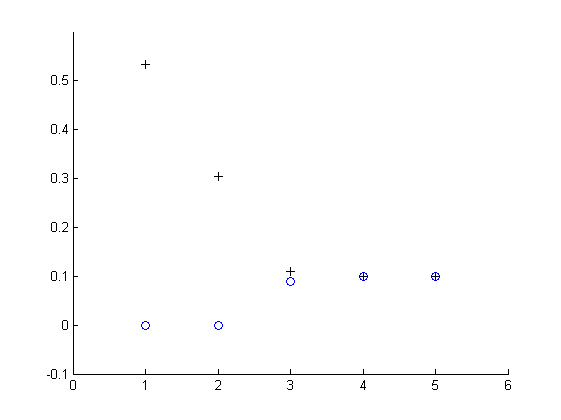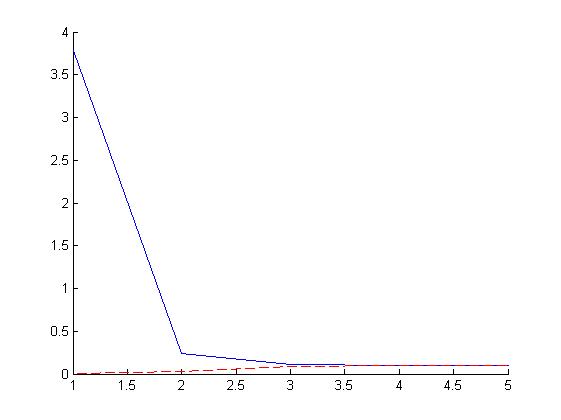Cvičení 3
Tak už má někdo výsledek? Mně to vyšlo pro lambdu i epsilon: 0.1000. Nějak se mi i podařilo vykreslit ten graf. (Třetí pokus :) )
0.100 mi taky vyšlo (a zimmermann neprotestoval) - mickapa1
Má to někdo podobně? Nebo i úplně jinak? — Martin Zachar 2009/10/06 19:06
— mickapa1, ale nema to smysl porovnavat, zalezi asi i dost na inicializacni mnozine ![]()
Ano, lambda a epsilon mi vyšly stejně. Ta lambda na 0 na začátku není špatný nápad ;) — Roman Polášek 2009/10/07 12:04
Uloha 1
Vcetne animace, jak algoritmus funguje, snad to nekterym pomuze v pochopeni. — Marek Sacha 2009/10/08 23:06
%%%%%%%%%%%%%%%%%%%%%%%%%%%%%%%%%%%%%%%%%%%%%% % Author: Marek Sacha <[email protected]> % %%%%%%%%%%%%%%%%%%%%%%%%%%%%%%%%%%%%%%%%%%%%%% clear clc close all load data1.mat % Initialize random set of starting active edges % ix = vector of potential starting x-coordinates ix = x(1); % iy = vector of potential starting x-coordinates iy = y(1); % Initialize the point of maximum divergence (initial set contains only one point) ixm = x(1); iym = y(1); % Initialize at, bt, lt at = 0; bt = 0; lt = 0; % Initialize totlerance e = 0.0004; % Initialize distance dist = abs(at*ixm+bt-iym); [ xh xw ] = size(x); % Begin loop while dist - lt > e test = dist - lt; % Get height of reduced vector x = height of reduced vector y, to be able % to constuct inequalities matrix for reduced problem [ ixh ixw ] = size(ix); % Construct inequalities matrix for reduced problem % | ix 1 -1 | % A = |-ix -1 -1 | % A = [ ix ones(ixh,1) -1*ones(ixh,1); -1*ix -1*ones(ixh,1) -1*ones(ixh,1) ]; % Construct right side for reduced problem % | iy | % b = | -iy | b = [ iy; -iy ]; % Construct function to be minimized % f = 0x + 0y + lambda f = [ 0; 0; 1]; % Run linprog o = linprog(f,A,b); % o = [ at bt lambdat ]; at = o(1); bt = o(2); lt = o(3); % Search for points of maximum distance (ixm, iym) and finally the maximum % distance max_dist = 0; for i=1:xh actual_dist = abs(at*x(i)+bt-y(i)); max_point_x = [ x(i) ]; max_point_y = [ y(i) ]; if actual_dist > max_dist max_dist = actual_dist; imx = max_point_x; imy = max_point_y; elseif actual_dist == max_dist imx = [ max_points_x ; max_point_x ]; imy = [ max_points_y ; max_point_y ]; end end dist = max_dist; if dist - lt > e ix = [ ix; imx ]; iy = [ iy; imy ]; end clf; hold on; % Print separate points plot(x,y,'y.'); % Print separate points plot(ix,iy,'r.'); % Approximation line plot(x,x*at+bt,'g'); % Top border plot(x,x*at+bt+lt,'c'); % Bottom border plot(x,x*at+bt-lt,'c'); hold off; pause(2); end at bt lt
Uloha 2,3,4
Konverguje v 5 krocich. — Marek Sacha 2009/10/08 23:06
%%%%%%%%%%%%%%%%%%%%%%%%%%%%%%%%%%%%%%%%%%%%%% % Author: Marek Sacha <[email protected]> % %%%%%%%%%%%%%%%%%%%%%%%%%%%%%%%%%%%%%%%%%%%%%% clear clc close all load data2.mat % Initialize random set of starting active edges % ix = vector of potential starting x-coordinates ix = x(1); % iy = vector of potential starting x-coordinates iy = y(1); % Initialize the point of maximum divergence (initial set contains only one point and in fact, why not random number one ;-)) ixm = x(1); iym = y(1); % Initialize at, bt, lt at = 0; bt = 0; lt = 0; % Initialize totlerance e = 0.0004; % Initialize distance dist = abs(at*ixm+bt-iym); % Initialize support vectors for final graph idist = [ dist ]; il = [ 0 ]; [ xh xw ] = size(x); % Begin loop while dist - lt > e test = dist - lt; % Get height of reduced vector x = height of reduced vector y, to be able % to constuct inequalities matrix for reduced problem [ ixh ixw ] = size(ix); % Construct inequalities matrix for reduced problem % | ix 1 -1 | % A = |-ix -1 -1 | % A = [ ix ones(ixh,1) -1*ones(ixh,1); -1*ix -1*ones(ixh,1) -1*ones(ixh,1) ]; % Construct right side for reduced problem % | iy | % b = | -iy | b = [ iy; -iy ]; % Construct function to be minimized % f = 0x + 0y + lambda f = [ 0; 0; 1]; % Run linprog o = linprog(f,A,b); % o = [ at bt lambdat ]; at = o(1); bt = o(2); lt = o(3); % Search for points of maximum distance (ixm, iym) and finally the maximum % distance max_dist = 0; for i=1:xh actual_dist = abs(at*x(i)+bt-y(i)); max_point_x = [ x(i) ]; max_point_y = [ y(i) ]; if actual_dist > max_dist max_dist = actual_dist; imx = max_point_x; imy = max_point_y; elseif actual_dist == max_dist imx = [ max_points_x ; max_point_x ]; imy = [ max_points_y ; max_point_y ]; end end dist = max_dist; if dist - lt > e ix = [ ix; imx ]; iy = [ iy; imy ]; idist = [ idist; dist ]; il = [ il; lt ]; else idist = [ idist; dist ]; il = [ il; lt ]; % Hurray, we are victorious % clf; hold on; % Print actual distance plot(1:(ixh+1),idist,'yo'); % Print lambda plot(1:(ixh+1),il,'r+'); hold off; % Print out requested results dist lt end end


